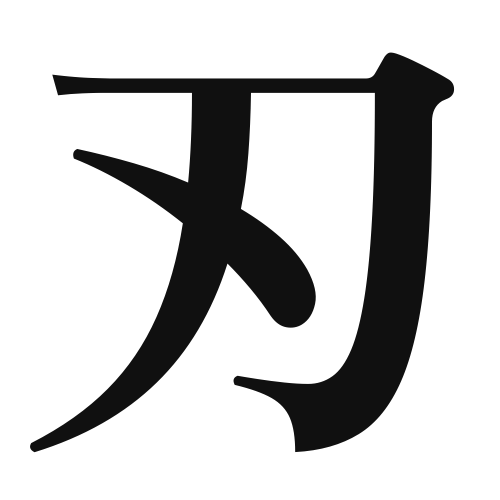1. Overview of Meaning
The kanji “刃” (ha) means “blade” or “edge.” It refers to the sharp part of a tool or weapon, such as a knife or sword, that is used for cutting.
2. Formation and Radical
Formation of the Kanji: The kanji “刃” is a pictogram, originally depicting a sharp edge. It is classified as a phonetic compound (形声文字), where the left part indicates the meaning related to cutting, and the right part provides the pronunciation.
Radical: The radical for “刃” is “刀” (katana), which means “sword” or “knife.” This radical is commonly associated with words related to cutting or sharp objects.
3. Examples of Usage
Common Words and Phrases:
- 刃物 (hamono) – cutting tools or knives
- 刃先 (hasaki) – the tip of a blade
Example Sentences in Daily Conversation:
- このナイフの刃はとても鋭いです。 (Kono naifu no ha wa totemo surudai desu.) – The blade of this knife is very sharp.
- 刃物を使うときは注意してください。 (Hamono o tsukau toki wa chūi shite kudasai.) – Please be careful when using cutting tools.
4. Synonyms and Antonyms
Similar Kanji:
- 鋭 (surudoi) – sharp, which describes the quality of being sharp but does not specifically refer to a blade.
- 切 (kiru) – to cut, which is a verb related to the action of using a blade.
Antonyms:
- 鈍 (nobun) – dull, which refers to the opposite quality of being sharp.
5. Cultural and Historical Background
Relation to Japanese Culture: The concept of “刃” is deeply embedded in Japanese culture, especially in the context of traditional crafts like sword-making (刀鍛冶, katana-kaji) and culinary arts. The katana, a symbol of samurai culture, is renowned for its sharp blade.
Proverbs and Idioms:
- 刃の上を歩く (ha no ue o aruku) – to walk on the edge of a blade, meaning to be in a dangerous or precarious situation.
